 Travel
Travel

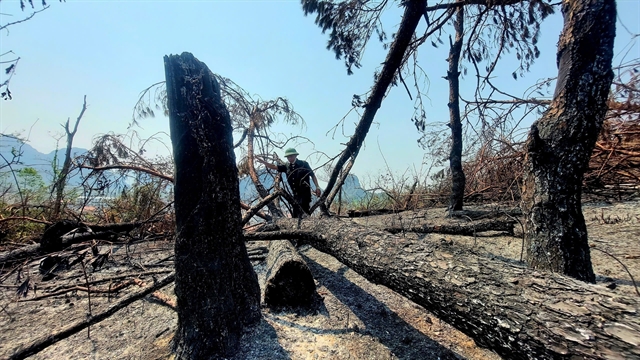 |
| After Typhoon Yagi, about 6 million tonnes of flammable dead leaves and broken branches remain on the forest floor, posing a high risk of fires during the dry season. VNA/VNS Photos Thanh Vân |
By Văn Đức & Thanh Vân
More than a month has passed since Typhoon Yagi swept through the northern region, yet foresters in Quảng Ninh Province are still reeling from its devastating effects.
Vast areas of damaged, dying forests, large piles of unusable timber, and a shortage of seedlings needed for recovery remain pressing challenges. The urgent task of reviving these forests has become critical for the province.
In just four hours on September 7, Yagi destroyed over 119,000 hectares of forests in the province, causing nearly VNĐ6.5 trillion (US$256.8 million) in economic losses related to forestry.
Travelling along Road 234, National Highway 279, and Highway 18, from Hạ Long City to Vân Đồn, Tiên Yên, Ba Chẽ, and Bình Liêu districts, one can see nothing but barren, withered trees.
According to Quảng Ninh’s Forestry Department, over 119,000 hectares of forest had been affected by the end of September, including more than 112,400ha of planted forests and over 6,600ha of natural forests.
A total of 22,390 households involved in forestry suffered losses, including those who were allocated forest land or contracted to plant lumber trees for local forestry companies.
Hạ Long City was the hardest hit, with damage estimated at VNĐ1.15 trillion ($45.4 million). Most of the damage occurred to planted forests, with more than 22,800 out of 37,000ha destroyed, resulting in losses of approximately $45 million. Special-use forests suffered 50ha of damage, valued at about $593,000.
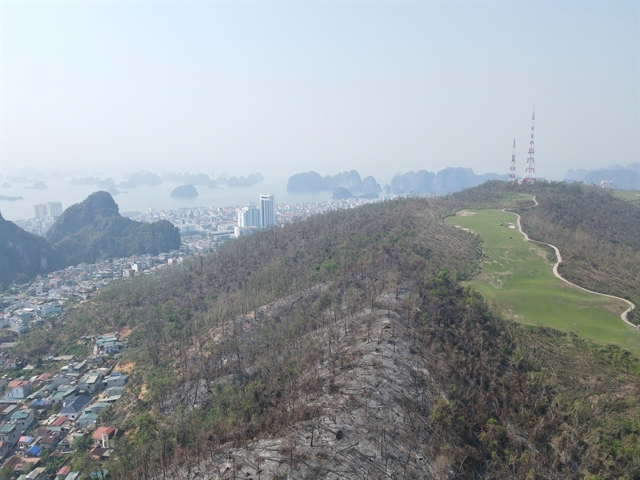 |
| The lush green forests in the northern coastal province of Quảng Ninh were devastated in just four hours after Typhoon Yagi made landfall in Việt Nam in early September. |
Burdened with debt
The immense destruction left dozens of foresters in debt and at risk of falling back into poverty.
Trinh Hồng Quyết, 63, in Khe Đồng Village in Tân Dân Commune, Hạ Long City, is one of those affected. His family owns around 30ha of forest, 14 of which are planted with acacia and eucalyptus trees aged two to three years. Just as they were preparing for harvest, Typhoon Yagi hit, leaving behind piles of uprooted trees.
“It is extremely difficult to find workers to clear the land, as everyone is busy cleaning up their own forests,” Quyết said.
"The daily wage for forest workers has risen from VNĐ200,000 to between VNĐ300,000-350,000, and yet it's still hard to find help.”
According to Quyết clearing fallen trees is much more challenging than regular logging. To make matters worse, the price for salvaged timber is low, with some buyers pressuring farmers to accept reduced rates due to the large volume of fallen trees. After covering all expenses, many forest owners are left with double losses and no income to rely on.
Quyết is particularly concerned about the shortage of seedlings needed for replanting. But seedling prices have skyrocketed, moreover the current supply is insufficient.
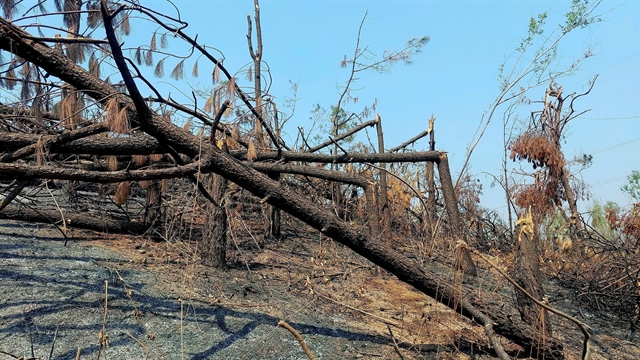 |
| Typhoon Yagi devastates over 119,000 hectares of forest in Quảng Ninh Province. |
Mounting concerns
Phạm Văn Hùng in Nà Sắn Village in Bản Sen Commune, Vân Đồn District, said that his family had suffered nearly $79,000 in losses. His 17-hectare forest was almost entirely destroyed by the storm.
“I plan to clear the land and replant in the coming spring,” Hùng said.
However, he faces another challenge: he had borrowed $11,850 from the bank and is unsure how to repay it, which complicates securing additional loans for forest restoration. He estimates that it will take at least five years before he can see any income from the forest again, emphasising the need for government support.
Trần Thị Vũ, 81, a native of Hà Tràng Tây Village in Đông Hải Commune, Tiên Yên District, is at risk of falling back into poverty. The typhoon not only destroyed her forest but also caused extensive damage to her home and belongings due to flooding. Despite her age, she continues to care for her ill son.
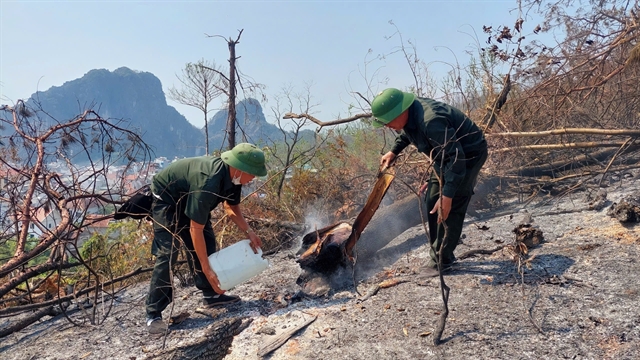 |
| Two forest rangers from Hồng Hà Ward in Hạ Long City discovers and promptly extinguishes a smoldering fire from a tree trunk during a tour of inspecting forest fire. |
Urgent forest restoration
Nguyễn Thanh Khương, deputy director of Quảng Ninh’s Forestry Department, said that forests were a primary source of income for many households. However, the recent devastation put their livelihood at risk.
Additionally, about 6 million tonnes of flammable dead leaves and broken branches remain on the forest floor, posing a high risk of forest fires during the dry season, according to Khương. Between September 28 and October 15 alone, 15 forest fires broke out, primarily in areas of acacia and eucalyptus trees damaged by the typhoon.
Restoring the province’s forest areas, referred to as the “green lungs” of the northeast region, has been identified by local authorities as an urgent priority.
The People’s Committee [Administration] of Quảng Ninh launched on October 1 an intensive campaign for damaged forest clearances, with the goal of completing the work by the end of the month. Local authorities have mobilised departments and organisations to assist foresters with cleanup efforts on weekends, while forestry companies continue their work daily.
However, as Hoàng Mai Dung, a resident of Sơn Hải Village in Nam Sơn Commune, Ba Chẽ District, pointed out, the selling prices for salvaged timber were too low to make up for the loss.
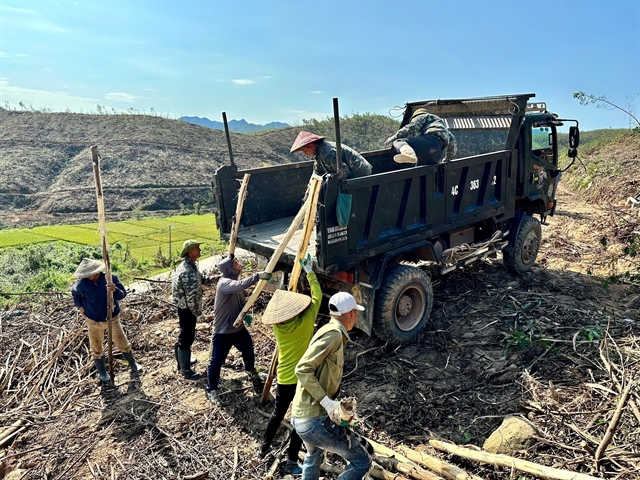 |
| Local foresters collect damaged timber trees, as Typhoon Yagi left a trail of destruction in its wake. |
Government support
Under the current government regulation governing support for agricultural production in areas affected by natural disasters, those with over 70 per cent of their forest area being damaged are entitled to financial support of $158 per hectare. Those with 30-70 per cent damage are eligible for VNĐ2 million ($79) per hectare.
To further support foresters, Quảng Ninh’s Forestry Department has proposed that the Department of Agriculture and Rural Development provide financial assistance through the Quảng Ninh Fatherland Front Fund. This includes VNĐ1 million ($39.50) per hectare for forest areas with more than 30 per cent damage, with the total budget for the first phase expected to be over $3 million.
Vũ Duy Văn, deputy director of the provincial Department of Agriculture and Rural Development, said that localities were making plans to replant the damaged forests, aiming to restore forest coverage by 2027.
Addressing concerns about seedling shortage, Văn said local nurseries could produce over 100 million seedlings annually. The agricultural sector would work with localities to guide farmers in seedling propagation and would help the local nurseries maximise their seedling production capacity. The department also reached out to the Việt Nam Academy of Forest Sciences and neighbouring provinces to source high-quality seedlings for local farmers.
Văn emphasised that the agricultural sector was focusing on long-term timber trees, native species, and multi-functional wood trees that are resilient to wind, storms, and pests.
 |
| Nurseries must hire additional labourers and extend working hours to urgently cultivate a large number of acacia seedlings for the upcoming reforestation season. |
Local authorities are guiding farmers to cultivate economically valuable, short-cycle crops, such as bamboo, which can provide both bamboo shoots as food, and raw materials for manufacturing.
Efforts to recover the forestry sector include damage assessments, collaboration with technology and forestry companies to research tree species, and working with banks to reschedule debt payments and offer favourable policies for reinvestment and recovery.
On July 10, 2024, the provincial People’s Council [Assembly] introduced special policies to encourage sustainable forestry development. The province is offering up to VNĐ20 million per hectare for seedling purchase and care, or VNĐ5 million higher than the national level.
Additionally, loans are being offered through the Social Policy Bank to cooperative members, households, and individuals for reforestation efforts, with an interest rate in line with those offered to low-income households. VNS




